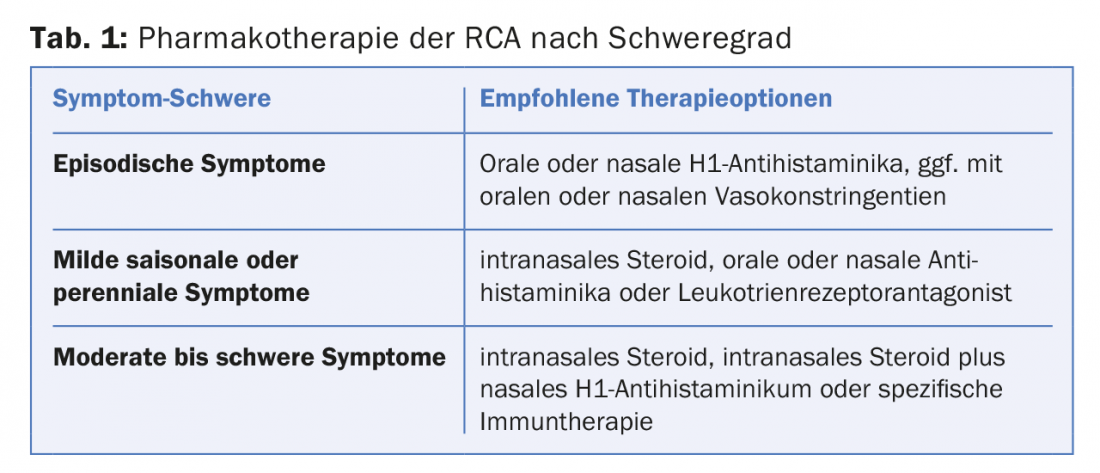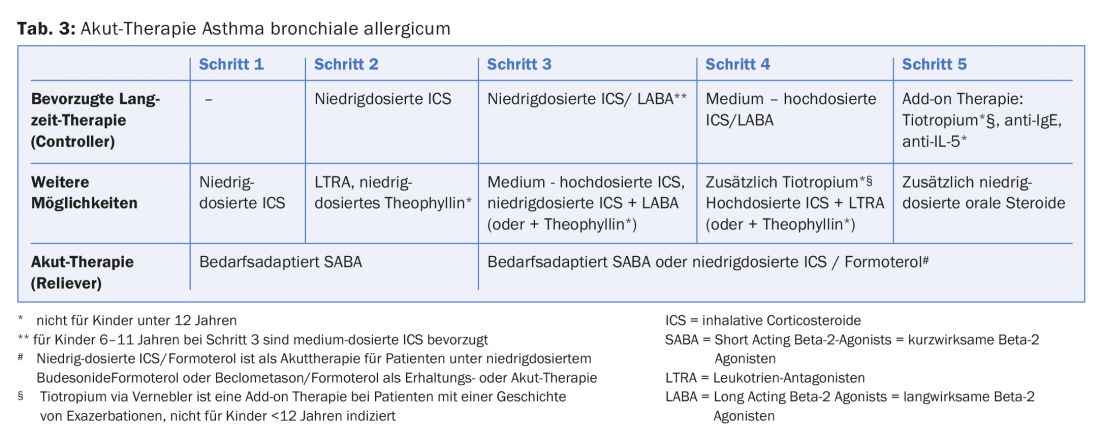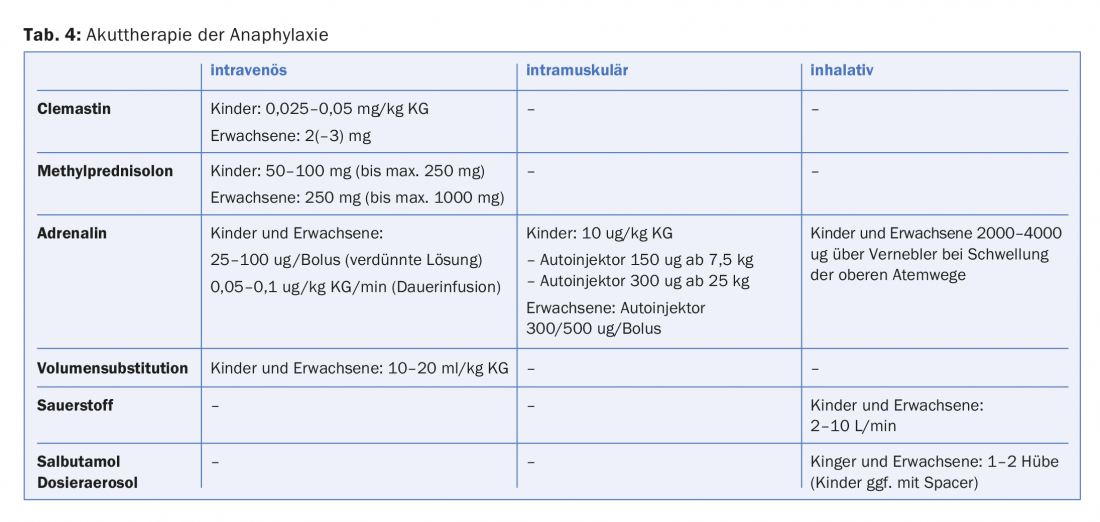A review of current recommendations in the acute treatment of the major allergic diseases of the upper and lower respiratory tract. Detailed tables on the acute therapy of rhinoconjunctivitis allergica (RCA), bronchial asthma allergicum, and anaphylaxis provide a compact quick reference.
Allergically triggered diseases are among the frequent acute problems in dermatological-allergological daily routine. It is important to identify the triggering agent and, in addition to acute (medicinal) measures, to aim for exposure prophylaxis or – if possible – specific immunotherapy (desensitization). Seasonal allergens include tree pollen and grasses, while perennial allergens include animal dander, dust mites and (mold) fungi. Depending on the severity, there may be an attack of the upper respiratory tract with rhinitis, conjunctivitis, combined rhinoconjunctivitis, lower respiratory tract with bronchial asthma allergicum as well as oral allergy syndrome or even an anaphylactic reaction.
This review provides a concise overview of current recommendations in the acute treatment of the major allergic diseases of the upper and lower respiratory tract. Here, the diagnosis and differential diagnosis of an allergic genesis is important and must be determined in advance.
Rhinoconjunctivitis allergica (RCA)
Allergic rhinitis, or hay fever or pollinosis, is the most common allergic disease and second most common form of rhinitis after infections. IgE-mediated immune reactions are mostly against pollen, mites, molds, and animal epithelia. Mucosal irritation may cause sneezing, itching, obstruction, rhinorrhea, headache, and olfactory disorders. Furthermore, there may be involvement of the conjunctiva, middle ear, pharynx, and paranasal sinuses. Patients also complain of fatigue, concentration and sleep disturbances, and reduced performance. In up to 25% of patients, a floor change with development of bronchial asthma occurs during the course of the disease. In the setting of atopy, up to 30% of patients with RCA have concomitant asthma and up to 10% have atopic dermatitis. A distinction is made between seasonal (tree pollen, grass and cereal pollen, herbs) and perennial (mites, (mold) fungi, animal epithelia), occupational (e.g., flour dust, laboratory animals, adhesives, latex) and rhinologic-associated (e.g., antibiotics, preservatives, ointment bases) allergens. After taking the patient’s history, a rhinoscopy and allergy tests such as prick and epicutaneous tests with provocation testing, if necessary, should be performed as well as laboratory tests with total IgE, specific IgE and determination of eosinophils (with eosinophil cationic protein (ECP), if necessary, both laboratory tests and nasal secretion) and tryptase. Imaging such as CT of the paranasal sinuses should be done to assess for sinusitis, polyps as well as anatomic abnormalities [1,2].

Therapies include education, allergen avoidance, symptomatic therapy, specific immunotherapy, and rhinosurgery. Depending on the severity (Tab. 1), examples of possible preparations are presented in Table 2 with indications. Acute therapy for RCA usually includes a combination of daily nasal rinses, topical steroids, direct systemic antihistamines if necessary, and ophthalmic agents if appropriate, depending on severity. Rhinologics, especially topical steroids also have an anti-inflammatory effect on conjunctivitis, but it takes several days for the effect to take hold. If topical steroids are not sufficient, a monopreparation can be supplemented against a combination with antihistamine. Vasoconstrictors also help in the short term, but they should not be used for more than 10 days to avoid rhinitis medicamentosa (privinism). Topical steroids, on the other hand, can be used for longer periods without risk of dependence potential. If the mucous membranes dry out, a locally moisturizing nasal ointment can be added. In cases of therapy resistance, systemic steroids have proven effective in the short term, e.g., over one week. If symptoms persist, consider systemic therapy with leukotriene antagonists (montelukast, zafirlukast), cromoglycic acid (sodium cromoglycate), or then escalation to biologics off-label for RCA such as omalizumab (anti-IgE) or mepolizumab (anti-IL-5) [3,4].

Asthma bronchiale allergicum
Bronchial asthma can be divided into extrinsic (allergic) and/or intrinsic (non-allergic) forms. In the following, we will discuss extrinsic asthma, whose main triggers are allergies to plant pollen, animal dander, house dust mites, molds, and occupational allergens such as flour dust and isocyanates. 10% of children as well as 5% of adults suffer from asthma, with 30% of adults suffering from intrinsic or extrinsic and 40% from a mixed form. Acute symptoms represent periodic, seizure-like dyspnea with expiratory dry rales such as whistling, wheezing, and humming and thoracic tightness, which can typically be triggered by noxious agents such as cigarette smoke, cold air, or dusts. Nocturnal symptoms with coughing fits are common.
In the anamnesis, emphatic attention should be paid to possible triggers (also occupationally associated). In addition, family history and diseases from the atopic group can be helpful (RCA, atopic eczema). Diagnostically, pulmonary function with spasmolysis are mandatory and should be supplemented by whole-body plethysmography and metacholine provocation, exhaled NO (nitric oxide). Cutaneous and serological allergen tests have already been discussed in the previous paragraph.
The goals of asthma therapy are to prevent acute and chronic complications, normalize lung function, prevent disease-associated impairment of child mental and physical development, daily activities, and asthma-associated lethality. In addition to drug therapy, non-drug measures such as patient education (correct use of inhalation systems, allergen abstinence, therapy self-management, peak flow meter), physical training and respiratory physiotherapy, choice of occupation, weight reduction and nicotine abstinence as well as vaccinations (influenza, pneumococcus) must also be carried out. Drug therapy is divided into continuous (controller) and acute (reliever) therapy. The respective therapy should always be gradually adjusted to the current need according to symptomatology, exacerbations, side effects, patient satisfaction and lung function in order to achieve disease control. An overview of drug therapy is shown in Table 3 [5].

Status asthmaticus is a particularly severe asthma attack that extends over a prolonged period of time and cannot be resolved by administration of the usual therapeutic measures. Status asthmaticus is a medical emergency that requires intensive care. The cause is a prolonged bronchospasm that ultimately leads to carbon dioxide intoxication with clouding of consciousness. Therapy is according to GINA guidelines, in particularly severe cases intubation with mechanical ventilation is necessary [5].
The allergic emergency
Anaphylaxis is a potentially life-threatening, acute systemic reaction with symptoms of an immediate allergic reaction that can affect the entire body. The triggers, which most commonly include drugs, insect venoms (bee, wasp), and foods (especially peanuts, tree nuts, fish/crustaceans, wheat, soy, chicken eggs, cow’s milk), can be ingested orally, parenterally, dermally, and by inhalation. Co- or augmentation factors include physical exertion, alcohol, infections, menstruation, and emotional stress. Symptoms may manifest singly or simultaneously on the skin/mucous membranes, respiratory system, cardiovascular system, and gastrointestinal tract.
Prodromes may manifest as itching/burning palmoplantar or genital, metallic taste, headache, or anxiety/agitation. Specific cutaneous and mucocutaneous manifestations include pruritus, urticaria/angioedema (including uvula, tongue, pharynx), erythema, conjunctivitis, lacrimation, and chemosis with clubbed speech, dysphagia, or inspiratory stridor as typical clinical signs. Respiratory distress, dry, staccato cough, wheezing, tachypnea, inspiratory and expiratory stridor, and prolonged expiration are signs of airway involvement. If the cardiovascular system is involved, tachycardia, hypotension, arrhythmias, bradycardia, reflex coronary spasm, and anaphylactic shock may occur. Cramping abdominal pain, nausea, vomiting, and diarrhea are typical signs of gastrointestinal involvement and may also occur with micturition, uterine cramping, and defecation. In hypotension and shock, sudden vomiting, involuntary defecation, and micturition may occur. Central nervous symptoms such as agitation, somnolence, convulsions, withdrawal behavior, and cognitive impairment may additionally be present and persist for days after the event. Anaphylactic events may resolve spontaneously or progress protracted to death within minutes. Rarely, a biphasic course occurs after six to twelve hours. Differentiation from differential diagnoses can be difficult and must be considered [6].
Emergency management includes basic measures as well as management of circulatory and respiratory function, skin and abdominal symptoms. Basic measures include stopping allergen delivery if not already done, alerting emergency medical services, checking vital signs including. Pulse, blood pressure and respiration (as well as blood glucose measurement), flat positioning (elevation of the legs in hemodynamically unstable situation), but semi-sitting in case of leading pulmonary symptoms. In case of cardiovascular arrest, immediately start cardiopulmonary resuscitation “30:2” (chest compressions to ventilation) and apply a defibrillator, if available, and administer epinephrine 0.3 mg i.m. (e.g., Epipen) to be administered (can be started after 10-20 min. repeated), sufficient oxigenation and i.v. volume substitution. In case of airway obstruction, inhalations of epinephrine or beta-2-sympathomimetics (salbutamol, terbutaline), terbutaline s.c. or reproterol i.v., if necessary, are advised. In case of skin involvement clemastine i.v. as well as methyl-prednisolone 250 mg i.v. (can be increased up to 1000 mg) as well as gastrointestinal also antiemetics. An overview of drug therapy is shown in Table 4 [7].

Conclusion
Allergic diseases represent one of the most frequent diagnoses in dermatological-allergological everyday life. Acute situations can occur frequently, especially with seasonal allergies, and require therapy as needed. The tables listed provide a quick overview of drug therapy for upper and lower respiratory tract diseases.
Take-Home Messages
- Therapies for rhinoconjunctivitis allergica (RCA) include education, allergen avoidance, symptomatic therapy, specific immunotherapy, and rhinosurgery.
- Drug therapy for asthma is divided into a continuous
- (controller) and acute therapy (reliever).
- Status asthmaticus is a medical emergency that requires intensive care.
Literature:
- Gerhards C, et al: [Not Available]. Ther Umsch 2016; 73(6): 349-55. doi: 10.1024/0040-5930/a000803.
- Wheatley LM, Togias A: Clinical practice. Allergic rhinitis. N Engl J Med 2015; 372(5): 456-463. doi: 10.1056/NEJMcp1412282
- Bousquet J, et al: Allergic rhinitis and its Impact on Asthma (ARIA): achievements in 10 years and future needs. J Allergy Clin Immunol 2012; 130(5): 1049-1062. doi: 10.1016/j.jaci.2012.07.053.
- Drugs allergic disorders. Treat Guidel Med Lett 2013; 11(129): 43-52.
- Reddel HK, Bateman ED, Becker A, et al: A summary of the new GINA strategy: a roadmap to asthma control. Eur Respir J 2015; 46(3): 622-39. doi: 10.1183/13993003. 00853-2015
- Werner-Busse A, et al: The allergic emergency-management of severe allergic reactions. J Dtsch Dermatol Ges 2014; 12(5): 379-87; quiz 88. doi: 10.1111/ddg.12309
- Hernandez L, et al: Anaphylaxis. Prim Care 2016; 43(3): 477-485. doi: 10.1016/j.pop.2016.04.002
DERMATOLOGIE PRAXIS 2017; 27(3): 6-10











